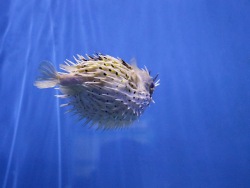Poisonous fish are moved to a separate tank

Two spot-fin porcupinefish (Diodon hystrix) have been placed in an individual aquarium in the “Tropical Seas” exhibit. The fish of this species are the largest representatives of the family Diodontidae: adult specimens grow up to an average of 40 cm in length. The spot-fin porcupinefish has an interesting peculiarity: in case of danger it inflates its body by swallowing water or air to become a spiky ball; the spines radiate outwards, and the fish looks much more threatening. But if the measures are not sufficient, the porcupinefish secretes a strong poison, tetrodotoxin, to defend against a predator. This toxin also is among the “weapons” of members of the family Tetraodontidae; the meat of some species is used in a famous Japanese dish called “fugu”.
“Our porcupinefish reside in the “Coral Reef” tunnel but it is not easy to take a close look at them there, and they are worth seeing. Besides their spiny “armour”, the fish have wonderful eyes that can change their colour from emerald green to azure blue,” said Mikhail Streltsov, Head of the Tropical Marine Fish Department.
In some species of the order Tetraodontiformes, the spot-fin porcupinefish belongs to, males attract the attention of females during the mating season in a unique manner – they “draw” unusual figures, circles crossed with straight lines, on the sand. The origin of the underwater drawings had been a mystery for a long time until scientists learnt that the traces on the sand were left by fish.
General information
The Latin name of the genus Diodon derived from two Greek words: dio – “two” and donti – “teeth”. The teeth of the spot-fin porcupinefish are fused together into two bony plates, one of which is located in the upper jaw, the other is in the lower jaw.